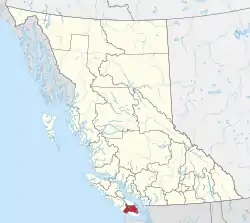Cowichan Valley Regional District
The Cowichan Valley Regional District is a regional district in the Canadian province of British Columbia is on the southern part of Vancouver Island,[3] bordered by the Nanaimo and Alberni-Clayoquot Regional Districts to the north and northwest, and by the Capital Regional District to the south and east. As of the 2021 Census, the Regional District had a population of 89,013. The regional district offices are in Duncan.
Cowichan Valley | |
|---|---|
| Cowichan Valley Regional District | |
 | |
|
Logo | |
 Location in British Columbia | |
| Country | Canada |
| Province | British Columbia |
| Administrative office location | Duncan |
| Government | |
| • Type | Regional district |
| • Body | Board of directors |
| • Chair | Ian Morrison (F) |
| • Vice chair | Sierra Acton (B) |
| • Electoral areas |
|
| Area | |
| • Land | 3,474.52 km2 (1,341.52 sq mi) |
| Population (2021)[2] | |
| • Total | 89,013 |
| • Density | 25.6/km2 (66/sq mi) |
| Website | www |
Geography
The Cowichan Valley Regional District covers an area between the Stuart Channel and Saanich Inlet on the east coast of Vancouver Island and the southern part of the West Coast Trail, with Cowichan Lake and Cowichan Valley proper located in its central region. It includes the Gulf Islands of Thetis, Penelakut and Valdes. The total land area is 3,473.12 km² (1,340.98 sq mi).
Communities
Incorporated communities
- City of Duncan - Pop 5,047
- Town of Ladysmith - Pop 8,990
- Town of Lake Cowichan - Pop 3,325
- District Municipality of North Cowichan - Pop 31,990
Indigenous Reserves
- Chemainus 13
- Claoose 4
- Cowichan 1
- Cowichan 9
- Cowichan Lake
- Est-Patrolas 4
- Halalt 2
- Kil-pah-las 3
- Kuper Island 7
- Lyacksun 3
- Malachan 11
- Malahat 11
- Oyster Bay 12
- Portier Pass 5
- Shingle Point 4
- Squaw-hay-one 11
- Theik 2
- Tsussie 6
- Wyah 3
E
- Cowichan Station
- Eagle Heights
- Glenora
- Koksilah
- Sahtlam
F
- Honeymoon Bay
- Mesachie Lake
- Skutz Falls
G
H
- Diamond
- North Oyster
- Yellow Point
I
- Meade Creek
- Youbou
Demographics
As a census division in the 2021 Census of Population conducted by Statistics Canada, the Cowichan Valley Regional District had a population of 89,013 living in 37,290 of its 40,174 total private dwellings, a change of 6.3% from its 2016 population of 83,739. With a land area of 3,472.48 km2 (1,340.73 sq mi), it had a population density of 25.6/km2 (66.4/sq mi) in 2021.[4]
| Panethnic group |
2021[5] | 2016[6] | 2011[7] | 2006[8] | 2001[9] | 1996[10] | 1991[11][12] | 1986[13][14][15]: 104 | ||||||||
|---|---|---|---|---|---|---|---|---|---|---|---|---|---|---|---|---|
| Pop. | % | Pop. | % | Pop. | % | Pop. | % | Pop. | % | Pop. | % | Pop. | % | Pop. | % | |
| European[lower-alpha 1] | 71,460 | 81.83% | 68,415 | 83.55% | 66,975 | 85.13% | 65,875 | 86.14% | 62,275 | 87.32% | 62,445 | 88.54% | 52,955 | 88.09% | 46,080 | 88.57% |
| Indigenous | 10,985 | 12.58% | 9,660 | 11.8% | 8,525 | 10.84% | 7,420 | 9.7% | 6,260 | 8.78% | 5,655 | 8.02% | 5,110 | 8.5% | 4,025 | 7.74% |
| South Asian | 1,295 | 1.48% | 1,260 | 1.54% | 1,150 | 1.46% | 1,440 | 1.88% | 1,360 | 1.91% | 1,235 | 1.75% | 1,155 | 1.92% | 1,380 | 2.65% |
| East Asian[lower-alpha 2] | 1,280 | 1.47% | 1,025 | 1.25% | 880 | 1.12% | 765 | 1% | 665 | 0.93% | 655 | 0.93% | 405 | 0.67% | 350 | 0.67% |
| Southeast Asian[lower-alpha 3] | 905 | 1.04% | 715 | 0.87% | 655 | 0.83% | 520 | 0.68% | 300 | 0.42% | 190 | 0.27% | 175 | 0.29% | 55 | 0.11% |
| African | 630 | 0.72% | 305 | 0.37% | 185 | 0.24% | 160 | 0.21% | 215 | 0.3% | 190 | 0.27% | 140 | 0.23% | 65 | 0.12% |
| Latin American | 265 | 0.3% | 150 | 0.18% | 100 | 0.13% | 95 | 0.12% | 65 | 0.09% | 30 | 0.04% | 30 | 0.05% | 35 | 0.07% |
| Middle Eastern[lower-alpha 4] | 140 | 0.16% | 130 | 0.16% | 35 | 0.04% | 75 | 0.1% | 75 | 0.11% | 70 | 0.1% | 145 | 0.24% | 35 | 0.07% |
| Other[lower-alpha 5] | 375 | 0.43% | 225 | 0.27% | 160 | 0.2% | 130 | 0.17% | 95 | 0.13% | 50 | 0.07% | — | — | — | — |
| Total responses | 87,330 | 98.11% | 81,885 | 97.79% | 78,675 | 97.94% | 76,475 | 99.41% | 71,315 | 99.05% | 70,525 | 99.36% | 60,115 | 99.27% | 52,025 | 99.16% |
| Total population | 89,013 | 100% | 83,739 | 100% | 80,332 | 100% | 76,929 | 100% | 71,998 | 100% | 70,978 | 100% | 60,560 | 100% | 52,466 | 100% |
- Note: Totals greater than 100% due to multiple origin responses.
Notes
- Statistic includes all persons that did not make up part of a visible minority or an indigenous identity.
- Statistic includes total responses of "Chinese", "Korean", and "Japanese" under visible minority section on census.
- Statistic includes total responses of "Filipino" and "Southeast Asian" under visible minority section on census.
- Statistic includes total responses of "West Asian" and "Arab" under visible minority section on census.
- Statistic includes total responses of "Visible minority, n.i.e." and "Multiple visible minorities" under visible minority section on census.
References
- "Board of Directors". Retrieved July 9, 2019.
- "Cowichan Valley Regional District". BC Geographical Names.
- "Population and dwelling counts: Canada and census divisions". Statistics Canada. February 9, 2022. Retrieved April 3, 2022.
- Government of Canada, Statistics Canada (October 26, 2022). "Census Profile, 2021 Census of Population". www12.statcan.gc.ca. Retrieved February 20, 2023.
- Government of Canada, Statistics Canada (October 27, 2021). "Census Profile, 2016 Census". www12.statcan.gc.ca. Retrieved February 20, 2023.
- Government of Canada, Statistics Canada (November 27, 2015). "NHS Profile". www12.statcan.gc.ca. Retrieved February 20, 2023.
- Government of Canada, Statistics Canada (August 20, 2019). "2006 Community Profiles". www12.statcan.gc.ca. Retrieved February 20, 2023.
- Government of Canada, Statistics Canada (July 2, 2019). "2001 Community Profiles". www12.statcan.gc.ca. Retrieved February 20, 2023.
- Government of Canada, Statistics Canada (June 4, 2019). "Electronic Area Profiles Profile of Census Divisions and Subdivisions, 1996 Census". www12.statcan.gc.ca. Retrieved February 20, 2023.
- Government of Canada, Statistics Canada (March 29, 2019). "1991 Census Area Profiles Profile of Census Divisions and Subdivisions - Part B". www12.statcan.gc.ca. Retrieved February 20, 2023.
- Government of Canada, Statistics Canada (March 29, 2019). "Data tables, 1991 Census Population by Ethnic Origin (24), Showing Single and Multiple Origins (2) - Canada, provinces and territories, census divisions and census subdivisions". www12.statcan.gc.ca. Retrieved February 20, 2023.
- Government of Canada, Statistics Canada (June 27, 2019). "Data tables, 1986 Census Census Profile for Canada, Provinces and Territories, Census Divisions and Census Subdivisions, 1986 Census - Part A". www12.statcan.gc.ca. Retrieved February 20, 2023.
- Government of Canada, Statistics Canada (June 27, 2019). "Data tables, 1986 Census Census Profile for Canada, Provinces and Territories, Census Divisions and Census Subdivisions, 1986 Census - Part B". www12.statcan.gc.ca. Retrieved February 20, 2023.
- Government of Canada, Statistics Canada (April 3, 2013). "Canada's aboriginal population by census subdivisions from the 1986 Census of Canada". www12.statcan.gc.ca. Retrieved February 20, 2023.